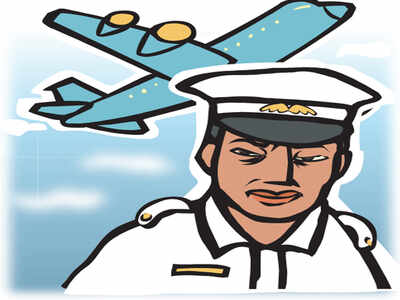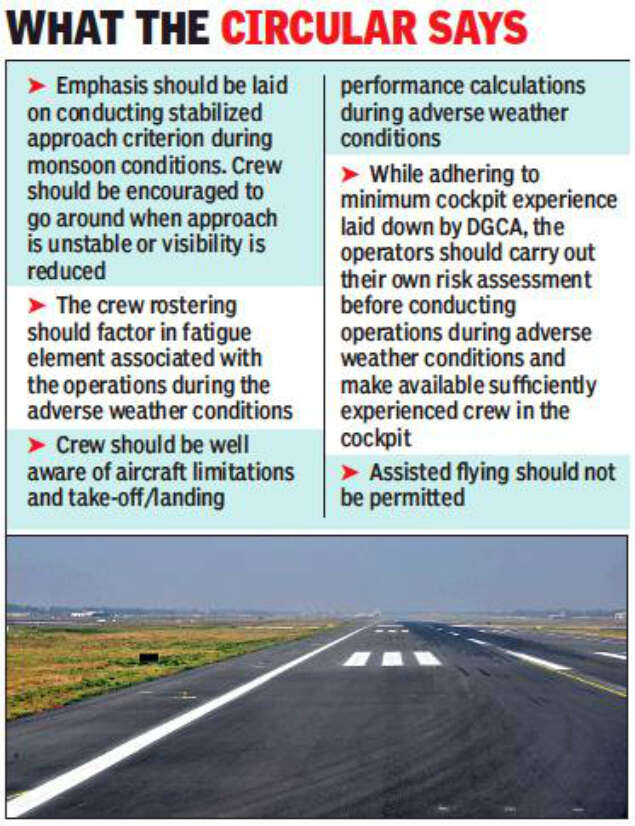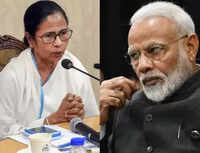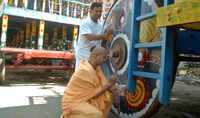
KOLKATA: The spate of landing incidents in the past five days at airports across the country, all of them involving low cost carriers (LCC) like the SpiceJet flight that skidded at Kolkata airport on Tuesday, has put the scanner on airlines’ practice of pushing pilots to the limit and throwing caution to the wind even in adverse conditions. Regulator Directorate General of Civil Aviation (DGCA) has suggested that airlines use experienced pilots during monsoon and placed an embargo on flying by lesser experienced co-pilots.

A Jet Airways flight from Pune had swerved dangerously to the right and grazed the runway edge lights on Tuesday afternoon before the pilot managed to steer the plane back to the central line. Five runway edge lights were damaged in the incident that left the passengers, as well as the crew, shaken. SpiceJet flights were involved in two other incidents while the remaining two involved Air India Express flights.
“Uncontrolled expansion by airlines has led to lowering of standards and pilots being pushed into the hot seat even if their proficiency is in question. These relatively inexperienced pilots get away when everything is fine. But when conditions are challenging, they fail to perform,” a veteran pilot said.
Monsoon poses challenging conditions to pilots, both en route as well as during take-off and landing. The latter is the most critical phase in a flight operation and all the incidents reported in the past five days have occurred during touch-down. While adverse weather conditions like wet runway, strong cross winds and rubber deposit contamination at touchdown zones can trigger such incidents, senior pilots did not rule out inept handling by the pilots.
“The incident at Kolkata airport happened at 2.33pm. But the weather report at Kolkata airport at 2.30pm wasn’t too adverse. Both rain and wind sheer was moderate and the pilot should have been able to deal with the conditions. The landing strip at Kolkata airport is also in fine condition with rubber deposits being scraped off regularly,” a captain of state-owned carrier Air India said.
Pilots said the air-safety circular issued on Tuesday reiterated the need for airlines to adhere to rules and guidelines on cockpit crew, including factoring in the fatigue element associated with operations during adverse weather conditions, while preparing the duty roster. Though DGCA has specified flight duty time limitation (FDTL), the maximum duty hours for a crew before mandatory rest, LCCs push the FDTL to the limit and don’t encourage a buffer, a source in a private carrier said.

A Jet Airways flight from Pune had swerved dangerously to the right and grazed the runway edge lights on Tuesday afternoon before the pilot managed to steer the plane back to the central line. Five runway edge lights were damaged in the incident that left the passengers, as well as the crew, shaken. SpiceJet flights were involved in two other incidents while the remaining two involved Air India Express flights.
“Uncontrolled expansion by airlines has led to lowering of standards and pilots being pushed into the hot seat even if their proficiency is in question. These relatively inexperienced pilots get away when everything is fine. But when conditions are challenging, they fail to perform,” a veteran pilot said.
Monsoon poses challenging conditions to pilots, both en route as well as during take-off and landing. The latter is the most critical phase in a flight operation and all the incidents reported in the past five days have occurred during touch-down. While adverse weather conditions like wet runway, strong cross winds and rubber deposit contamination at touchdown zones can trigger such incidents, senior pilots did not rule out inept handling by the pilots.
“The incident at Kolkata airport happened at 2.33pm. But the weather report at Kolkata airport at 2.30pm wasn’t too adverse. Both rain and wind sheer was moderate and the pilot should have been able to deal with the conditions. The landing strip at Kolkata airport is also in fine condition with rubber deposits being scraped off regularly,” a captain of state-owned carrier Air India said.
Pilots said the air-safety circular issued on Tuesday reiterated the need for airlines to adhere to rules and guidelines on cockpit crew, including factoring in the fatigue element associated with operations during adverse weather conditions, while preparing the duty roster. Though DGCA has specified flight duty time limitation (FDTL), the maximum duty hours for a crew before mandatory rest, LCCs push the FDTL to the limit and don’t encourage a buffer, a source in a private carrier said.
Quick Links
Lok Sabha Election Schedule 2019Lok Sabha Election NewsDelhi Capitals teamMI team 2019Rajasthan Royals 2019RCB team 2019Maharashtra Lok Sabha ConstituenciesBJP Candidate ListBJP List 2019 TamilnaduShiv Sena List 2019AP BJP List 2019Mamata BanerjeeBJP List 2019 MaharashtraPriyanka GandhiBJP List 2019 KarnatakaAMMK Candidate List 2019BJP List 2019 WBLok Sabha Elections in Tamil NaduBSP List 2019 UPNews in TamilLok Sabha Poll 2019Satta Matka 2018PM ModiMahagathbandhanNagpur BJP Candidate ListChandrababu NaiduTamil Nadu ElectionsUrmila MatondkarNews in TeluguMadras High CourtTejashwi YadavArvind KejriwalTejasvi SuryaPawan KalyanArvind KejriwalYogi AdityanathJaya PradaSatta King 2019Srinagar encounter
Get the app









